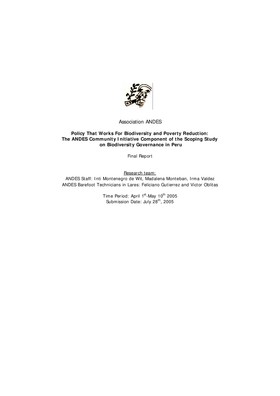Policy That Works For Biodiversity and Poverty Reduction: The ANDES Community Initiative Component of the Scoping Study on Biodiversity Governance in Peru
With 84 lifezones and 11 natural ecoregions, Peru is one of the most biodiverse countries in the world. Meanwhile, the levels of rural poverty in Peru—whether measured narrowly according to
income levels or more holistically taking into account various aspects of poverty—are persistently high.
Considering that many of the poorest indigenous people depend on biodiversity resources for employment, income, agriculture, food, medicines, clothing, shelter and other goods and services
essential for livelihoods, the erosion of biodiversity and/or the restriction of access to the many benefits arising from the use of biodiverse resources exacerbates rural poverty. Current national priorities to, on the one hand, conserve biodiversity and, on the other, combat poverty dictated by Peru’s commitments to meeting the objectives of the Convention on Biological Diversity (CBD) and the Millennium Development Goals (MDG’s) should be addressed together, recognizing the fundamentally
inter-linked nature of biodiversity conservation and poverty reduction.
Cite this publication
Available at https://www.iied.org/g01241
